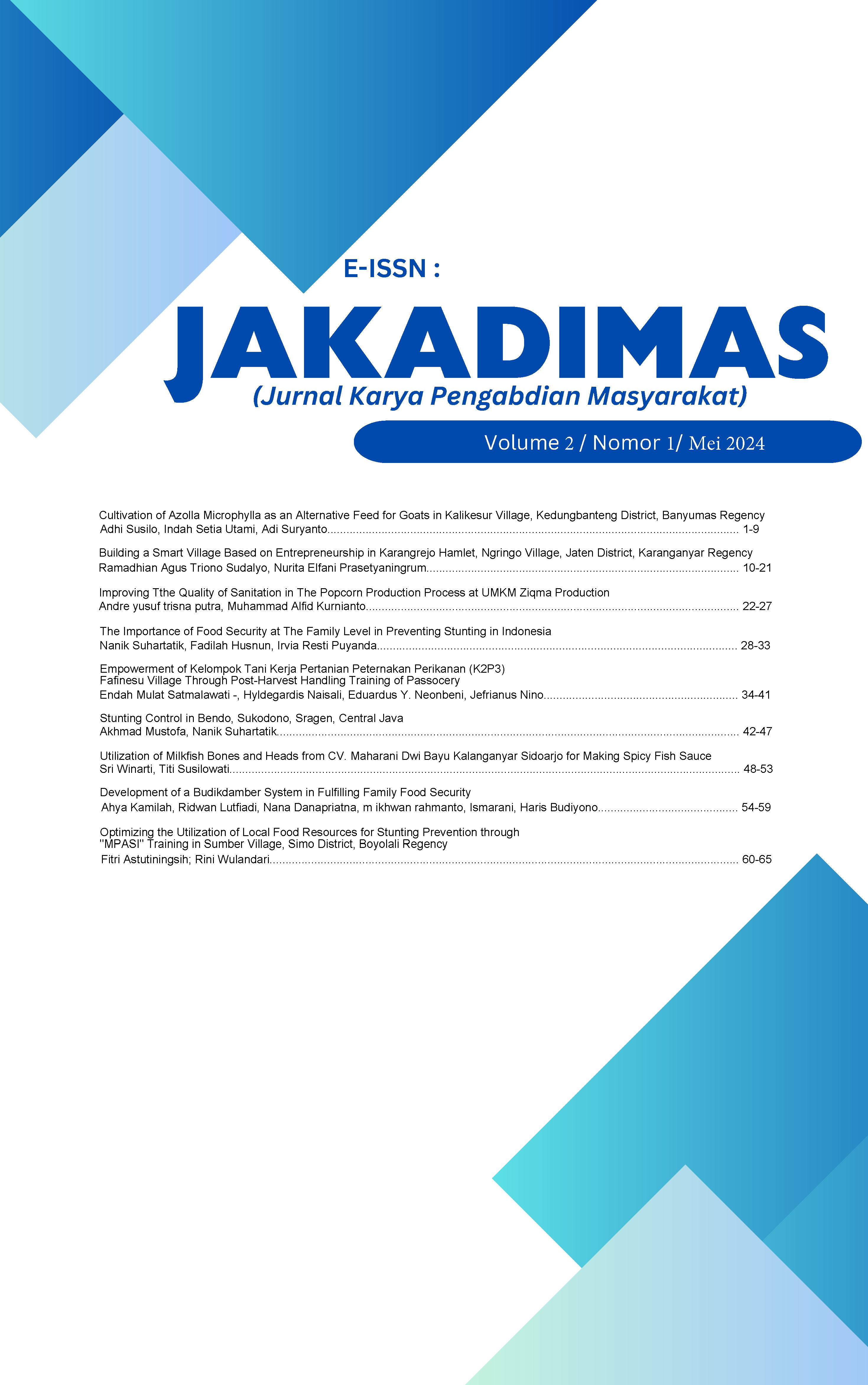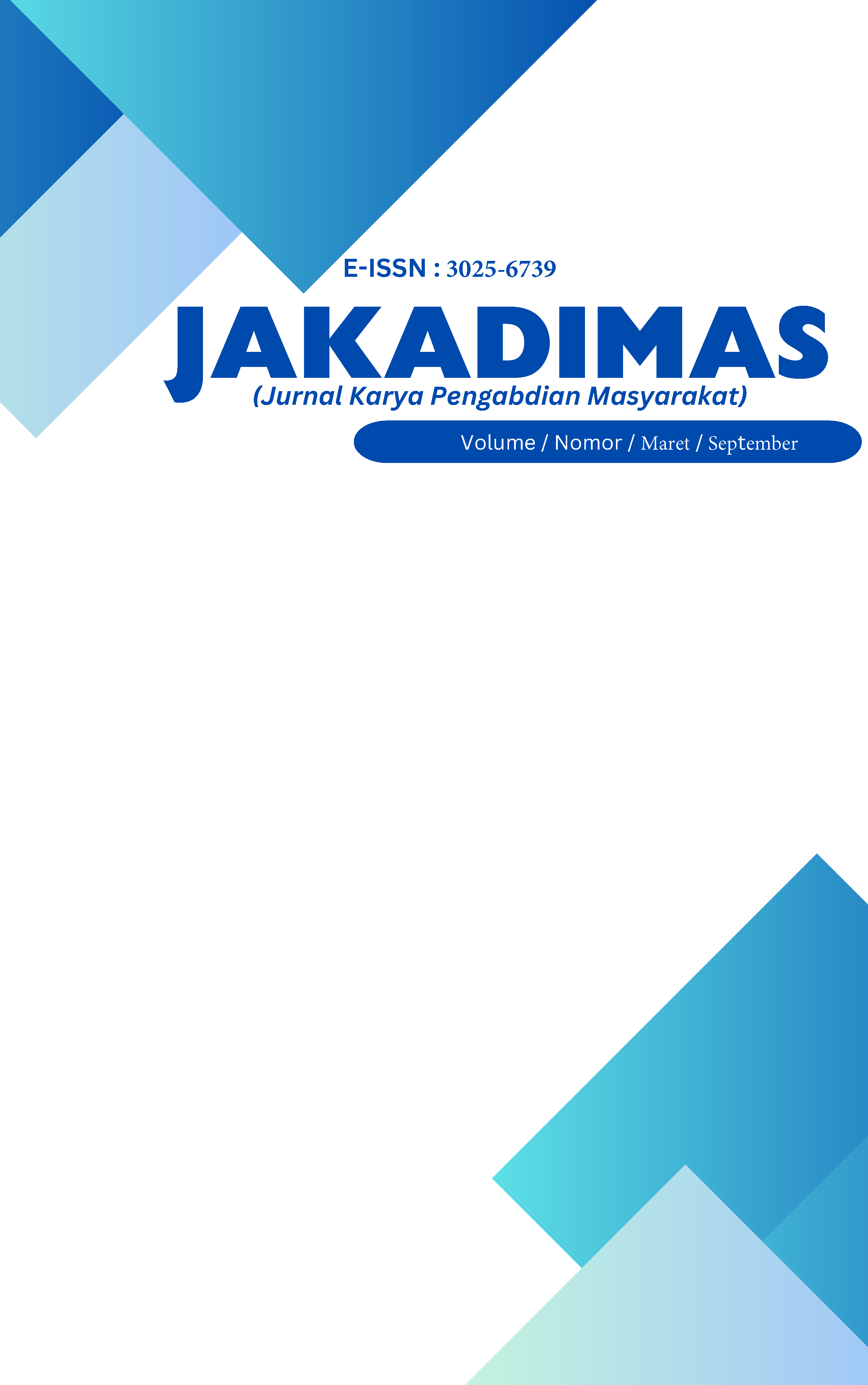Optimizing the Utilization of Local Food Resources for Stunting Prevention through "MPASI" Training in Sumber Village, Simo District, Boyolali Regency.
Optimalisasi Pemanfaatan Sumber Daya Pangan Lokal untuk Pencegahan Stunting melalui Pelatihan MPASI di Desa Sumber, Kecamatan Simo, Kabupaten Boyolali
DOI:
https://doi.org/10.33061/jakadimas.v2i1.10788Keywords:
Stunting, Community Servise, MPASI, Local Food IngredientAbstract
Sumber village, located in Simo district, Boyolali regency, faces a serious stunting problem. Stunting occurs due to prolonged nutritional deficiencies during critical growth periods in children, which are closely linked to cognitive development and long-term health risks. According to the Boyolali Health Department (2024), there has been an 8.9% increase in stunting cases, amounting to 4.913 cases in the Boyolali regency, with Simo district contributing 111 cases. To address this issue, the FATIPA UNISRI Community Service Team implemented a program to enhance knowledge and skills in preparing Complementary Foods for Breast Milk (MPASI) using locally available ingredients. This training was held in two sessions. "The first initiative focuses on stunting prevention outreach, while the second involves hands-on training in preparing MPASI." The results showed a significant increase in participants' knowledge and skills regarding stunting prevention and nutritious MPASI preparation, which is expected to reduce the prevalence of stunting in the village.
References
Ahsan, U., Shaid, A., Kiran, Z., Ahmed, I., Naqvi, S. M. S., & Zia-ur-Rehman, M. (2020). Nutritional and nutraceutical analysis of organic and conventional eggs. Journal of Food Processing and Preservation, 44(9), e14684.
Carvalho, A. T., Muniz, L. C., Menezes Netto, A., & Medeiros, J. S. (2015). A simplified diet for full-term infants from an urban area in northeastern Brazil: a randomized clinical trial. Nutrientes, 7(12), 10452-10464.
Caudill, M. A. (2019). Choline. Advances in Nutrition, 10(3), 538-540.
Chiu, T. H. T., Lin, S. P., Yeang, C. H., Deng, F. C., Chiang, Y. C., Chung, Y. C., & Huang, P. C. (2018). Effects of dietary patterns on childhood obesity and its related factors in Taiwan: a cross-sectional study. Nutrients, 10(11), 1661.
Dewey, K. G., & Begum, K. (2011). Longâ€term consequences of stunting in early life. Maternal & Child Nutrition, 7, 5-18.
Dinkes boyolali (2024). https://dinkes.boyolali.go.id/kesgiz diakses pada 25 Mei 2024
Kementerian Kesehatan RI. (2018). Panduan Penyelenggaraan Pemberian Makanan Bayi dan Anak. https://www.kemkes.go.id/resources/download/pusdatin/profil-kesehatan-indonesia/Panduan-Penyelenggaraan-Pemberian-Makanan-Bayi-dan-Anak.pdf diakses pada 20 Mei 2024
Kumordzie, S. M., Adu-Afarwuah, S., Arimond, M., Young, R. R., Adom, T., Boatin, R., & Dewey, K. G. (2019). Adherence to complementary feeding recommendations is associated with higher nutrient status among children 6-23 months of age in Ghana. Journal of Nutrition, 149(12), 2155-2166.
Orsavova, J., Misurcova, L., Ambrozova, J. V., Vicha, R., & Mlcek, J. (2015). Fatty acids composition of vegetable products determined by gas chromatography–flame ionization detection. International Journal of Food Science & Technology, 50(2), 492-498.
Poelman, A. A., Delahunty, C. M., & de Graaf, C. (2019). Vegetable preparation practices for 5-6 years old children more effectively promote intake and liking than flavour–flavour learning and repeated exposure: a randomized controlled trial. Food Quality and Preference, 71, 440-450.
Razis, A. F. A., Ibrahim, M. D., & Kntayya, S. B. (2018). Health benefits of Moringa oleifera. Asian Pacific Journal of Cancer Prevention, 19(8), 2083-2094.
Wiraguna, A. A. G. P., Sarbini, S. R., & Wiranatakusuma, L. G. (2021). Fatty acid profiles of infant foods supplemented with coconut milk. Jurnal Teknologi dan Industri Pangan, 32(1), 34-41.
World Health Organization. (2020). Infant and young child feeding. https://www.who.int/news-room/fact-sheets/detail/infant-and-young-child-feeding diakses pada 15 Mei 2024
Downloads
Published
How to Cite
Issue
Section
License
Copyright (c) 2024 Fitri Astutiningsih; Rini Wulandari

This work is licensed under a Creative Commons Attribution-ShareAlike 4.0 International License.
Authors who publish with this journal agree to the following terms:
- Copyright on any article is retained by the author(s).
- The author grants the journal, right of first publication with the work simultaneously licensed under a Creative Commons Attribution License that allows others to share the work with an acknowledgment of the work’s authorship and initial publication in this journal.
- Authors are able to enter into separate, additional contractual arrangements for the non-exclusive distribution of the journal’s published version of the work (e.g., post it to an institutional repository or publish it in a book), with an acknowledgment of its initial publication in this journal.
- Authors are permitted and encouraged to post their work online (e.g., in institutional repositories or on their website) prior to and during the submission process, as it can lead to productive exchanges, as well as earlier and greater citation of published work.
- The article and any associated published material is distributed under the Creative Commons Attribution-ShareAlike 4.0 International License








